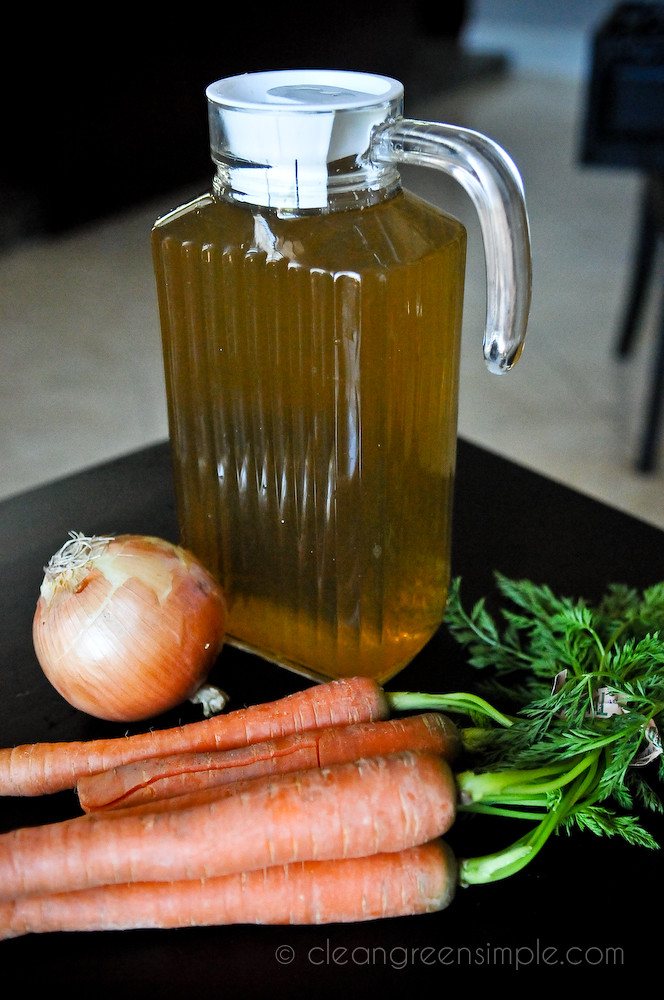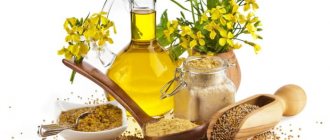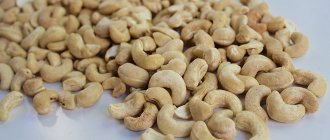Beneficial features
Flaxseed oil is considered especially beneficial for the female body.
This is due to its composition, which contains unsaturated fatty acids Omega 3, Omega 6 and Omega 9. Moreover, the first component is not synthesized by the human body, so it must be supplied with food in the required dosage. In addition, the oil contains antioxidants (vitamins E and C). These fatty acids, like all fats, act as a source of energy and also serve as “building material” for cell membranes and membranes, promoting the mobility and necessary permeability of the latter. In addition, Omega 3 helps normalize cholesterol levels and prevents the formation of cholesterol plaques on the walls of blood vessels.
Of course, such an effect is beneficial for every person, but it is especially valuable for the body of a pregnant woman. During this period, the blood may already have a higher viscosity, which makes it difficult to pass through the vessels. The presence of obstacles in the form of plaques will only aggravate the situation and may result in insufficient saturation of the tissues of the mother and fetus with oxygen and beneficial elements.
Deficiency itself leads to the clumping of blood cells (red blood cells). As a result, blood viscosity increases and, as a result, the risk of developing thrombosis. Thus, one of the beneficial functions of flax seed oil during pregnancy is improving blood flow in a woman’s body, as well as between mother and fetus. This, in turn, reduces the likelihood of fetal hypoxia, severe mental and neuralgic disorders.

Thanks to the oil’s ability to improve cell nutrition and increase the elasticity of vascular walls, as well as the presence of powerful antioxidants in the composition, we can talk about the strengthening, immunostimulating effect of the product on the body of a pregnant woman. Resistance to viral and colds and the effects of negative environmental factors increases.
One of the main properties of the oil is its ability to normalize hormonal levels. This is due to the presence of phytoestrogens in the product, similar to female hormones (estrogens). A deficiency of this hormone complicates the process of conception and also increases the risk of miscarriage. By replacing missing hormones, phytoestrogens help stabilize a woman’s hormonal levels, which is beneficial for the course of pregnancy and the formation of the fetus. It is worth noting that taking phytoestrogens in the oil helps to get pregnant if difficulties with conception are caused by hormonal imbalances.

Flaxseed oil and the fatty acids it contains, especially Omega 3, bring no less benefit to the fetus. It has been proven that the components penetrate the placenta and are used by the child’s body to form certain parts of the brain and visual organs. Omega 3 and 6 are especially necessary for a child born prematurely or during a severe pregnancy, since in this case the fetus experiences a deficiency of these fatty acids.

In the later stages, the use of a small amount of products allows you to prepare certain organs for childbirth, in particular, to soften the cervix. This ensures better opening during childbirth.
During lactation, it is recommended to consume the oil not in its pure form, but by adding it to cereals and salads. This will allow the baby to pass on beneficial Omega fatty acids and vitamin E. The latter is believed to improve the taste of milk. However, when it comes to recommendations regarding the use of a particular product during breastfeeding, it is necessary to take into account the health status of the baby.
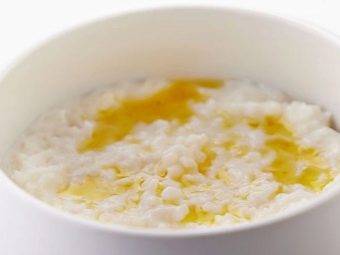
General rules
Breastfeeding is a natural way of feeding your baby. Human milk is an optimal product, highly digestible with a balanced content of all nutritional nutrients, including biologically active substances that protect the immature child’s body from the effects of adverse factors. However, the composition of milk is largely determined by the mother's diet. Therefore, a woman’s nutrition during breastfeeding is the most important factor in the child’s health, since almost everything that a woman eats is present in milk in one form or another.
Unfortunately, there is no single view on nutrition during breastfeeding. First of all, approaches to nutrition for nursing mothers in post-Soviet states and other civilized countries vary significantly, and this especially applies to various dietary restrictions/numerous prohibitions that can be found in the CIS countries.
Unlike such countries, there are practically no restrictions on the diet of a nursing woman in most countries of the world. A nursing mother, if desired, can eat almost any food in reasonable quantities. After all, a woman herself can monitor the connection between the consumption of certain products and the well-being of the child. And if she sees that your child’s health is normal, then why limit herself, and if the child has any problems, then she herself will adjust her diet. So where is the truth? Let's see what Dr. Komarovsky, a recognized authority in most families with children, writes about this.
First of all, according to Komarovsky, the diet of nursing mothers should be as varied as possible and include cereals and pasta, fermented milk products without additives, cottage cheese, dietary types of meat and fish, vegetables, fruits, and nuts. The main principle of drawing up a diet is its balance, that is, it must contain all the necessary components needed by the child - proteins, fats, carbohydrates, vitamins (C, D, group B), minerals (calcium, iodine, iron, magnesium), unsaturated fatty acids ( omega-3 and omega-6).
The calorie content of a woman’s daily diet in the first six months should be about 2700-2800 kcal. Reducing caloric intake is not recommended, as this is dangerous for the child. You will lose weight and regain your figure later. Insufficient nutrition of the mother leads to insufficient milk production, accordingly, the child will not receive enough nutritional nutrients. In this case, the baby develops excessively watery stools that are close in consistency to water, the baby loses the rate of weight gain, the baby is lethargic, sleeps a lot, the urine acquires a pungent odor, and signs of dehydration appear (recession of the fontanel).
It is also worth remembering that cooking food by frying is accompanied by the addition of fat, so it is better to limit fried foods or consume them in small quantities.
This is especially true for vegetables, which during this period must be present in the diet, but it is better to consume them boiled or baked, as well as products with a high allergenic potential (whole cow/goat milk, cocoa and coffee). You should also more closely monitor the diet until the child is three months old, since during this period the child is most often susceptible to colic.
When choosing products, preference should be given to fresh natural products, avoiding products containing GMOs, dyes, preservatives, and flavor enhancers. Therefore, you should not include semi-finished products, fast food products, or canned food in your diet.
As for restrictions, according to Komarovsky, the nutrition of a nursing mother should exclude:
- Products that change the taste of milk (spicy, salty, sour and smoked products) and its smell (garlic, onion).
- Potentially highly allergenic foods (sweets, citrus fruits, chicken eggs, whole milk, red and yellow vegetables/fruits, chocolate, caffeine-containing drinks).
- Legumes and white cabbage, black bread, pickled vegetables, bananas, grapes, kvass, cucumbers, confectionery products that cause intestinal upset in a child (flatulence, diarrhea).
To do this, you can keep a food diary in which the mother displays her menu, newly introduced foods into the diet and the baby’s reaction. If you are in doubt about any product (it is possible or not), eat a little and monitor the child’s reaction. If a rash does not appear, stool and sleep have not changed - introduce the product into the diet, but not immediately in large quantities, but gradually, increasing its content over 2-3 days. This algorithm for introducing a new product is important because there is a time lag between the use of the product, its quantity and the manifestation of an allergic reaction. Keeping a diary and carefully monitoring the child’s reaction to newly introduced foods will help timely and accurately determine the allergenic factor. If a rash or gastrointestinal upset appears, the cause must be sought in a new product introduced recently.
Equally important for sufficient and prolonged lactation is the drinking regime. The volume of liquid consumed should be at least 1.5 l/day, mainly in the form of still table water, compotes, fruit drinks, and green tea. It is recommended to drink 200 ml of water 10-15 minutes before feeding the baby. You should not drink more than normal fluids, as this can cause excess milk production and stagnation (lactostasis), and also increases the load on the kidneys.
Can pregnant women eat flax seeds? The whole truth about seeds
Every woman, while expecting a child, strives to balance her diet in such a way as to convey as many useful substances as possible to the baby in the womb. In this case, preference is given not to medicines, but to natural products. Flax seeds help provide the expectant mother's body with the necessary substances during pregnancy.
From this article you will learn:
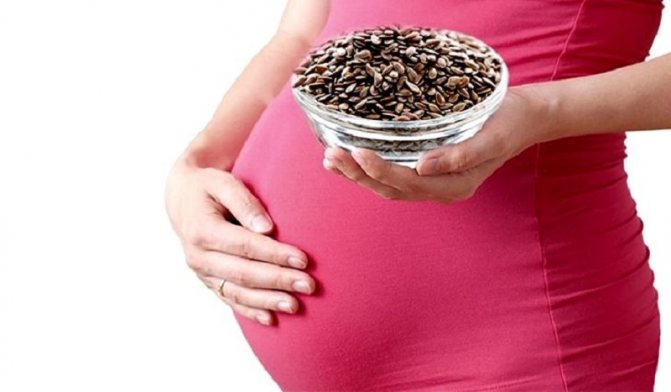
Rich composition of flaxseed
Flax seeds are one of the most important sources of not only vitamins A and E, which are considered “vitamins of youth,” but also the following elements:
- lignans, which regulate the level of the hormone estrogen in the body;
- fiber, which helps regulate digestion;
- polyunsaturated fatty acids Omega 3, 6 and 9, which have a positive effect on the development of the child’s brain;
- biologically active and easily digestible protein containing 8 amino acids;
- and many more useful substances.
Omega 3 contained in flax seeds reduces cholesterol levels in the blood, helps fight hypertension and prevents the occurrence of certain types of cancer.
Flax seeds during pregnancy, their benefits
Flax seeds are especially important during pregnancy. Vitamins A and E have a beneficial effect on the skin, reduce the risk of stretch marks, lignans help prevent hair loss, which also sometimes affects pregnant women
Vitamins A and E have a beneficial effect on the skin, reduce the risk of stretch marks, and lignans help prevent hair loss, which also sometimes affects pregnant women.
The fiber contained in flax seeds normalizes digestion and naturally eliminates constipation, which often occurs in the last stages of pregnancy. Kissel made from ground flax seed helps against heartburn.
Studies have shown that taking flaxseed oil during pregnancy promotes more active brain development in the baby.
Among other things, flax seeds strengthen the immune system of the expectant mother, increase the elasticity of blood vessels and prevent the formation of cholesterol plaques. Also, an important effect of taking flax seeds is a decrease in blood pressure, which is especially important in the last trimester.
Harm and contraindications of flax seeds during pregnancy
In addition to the obvious advantages, there are also some contraindications that are also worth considering.
Since lignans affect estrogen levels, it is not recommended to consume flax seeds in the first trimester if there is increased uterine tone, the threat of miscarriage and hormonal imbalance.
Contraindications also include:
- stomach ulcer;
- cholelithiasis;
- uterine fibroid, which itself has a negative effect on the course of pregnancy;
- blockage of the ureter;
- intestinal obstruction.
The use of flaxseed in this case can lead to an exacerbation of an existing disease: provoke an exacerbation of ulcers, the passage of stones - therefore, if you have one of the above diagnoses, taking flax seeds is strictly contraindicated. In all other cases, before introducing the product into your diet, you should definitely consult your doctor.
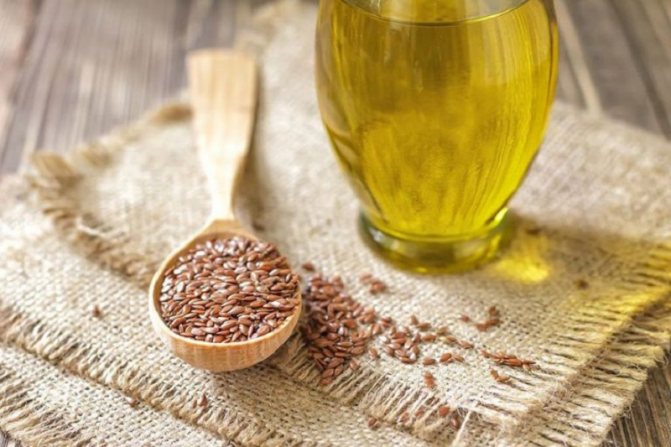
How to take the product during pregnancy
Before eating flax seeds, it is recommended to grind them in a coffee grinder or blender - this will increase the area of contact of the product with the intestines and facilitate the absorption of beneficial microelements. Most often, flax seeds are taken in one of three ways: in the form of a decoction, jelly or prepared oil.
It is better to store ground seeds in an airtight container. Over time, they lose their beneficial properties, so it is not recommended to grind large portions at once.
To prepare a decoction of flax seeds:
Pour 1 tablespoon of flax seeds into a glass of boiling water and leave for about 30 minutes, then filter and drink warm.
Kissel is prepared from ground grains:
Brew 2 teaspoons in 200 ml of water, boil for 10 minutes, stirring constantly, and drink without straining.
Flaxseed oil also contains the entire range of beneficial properties of the product, with the exception of plant fiber, so if you have digestive problems, it is recommended to take the seeds.
Published: 11/18/2017 (Updated: 02/05/2018)
All the benefits
Pregnancy somewhat reduces a woman’s body’s defenses; this is completely normal and natural. How to avoid getting sick for 9 months while carrying a baby? Is it possible? The answer may be positive, but for this you need to strengthen your immunity. The fatty acids contained in flaxseed protect the expectant mother from respiratory diseases throughout her entire life.
Flax seed itself has feminine energy, as it contains hormones similar to ours. The correct level of “pregnancy hormones” is vital for its normal course, as well as to eliminate the threat of its termination.
Thanks to selenium and all kinds of nutrients, the fetus begins to develop harmoniously, vitamin “E” firmly holds the baby in the uterus, preventing the threat of miscarriage. Folic acid helps give birth to a smart baby with a healthy nervous system.
Linen makes connective tissues and skin elastic; the risk of stretch marks during pregnancy and ruptures during labor is significantly reduced. While taking the fruits of this plant, the expectant mother will no longer be bothered by cramps.
Beneficial features
Flaxseed oil is a source of polyunsaturated alpha-linoleic fatty acid, vitamins E, A, K, F. To compensate for the deficiency of fatty acids and vitamins in a weakened body, it is recommended to take a teaspoon of this oil in the morning on an empty stomach, half an hour before meals. The course of treatment is about two months, after which you should take a break.
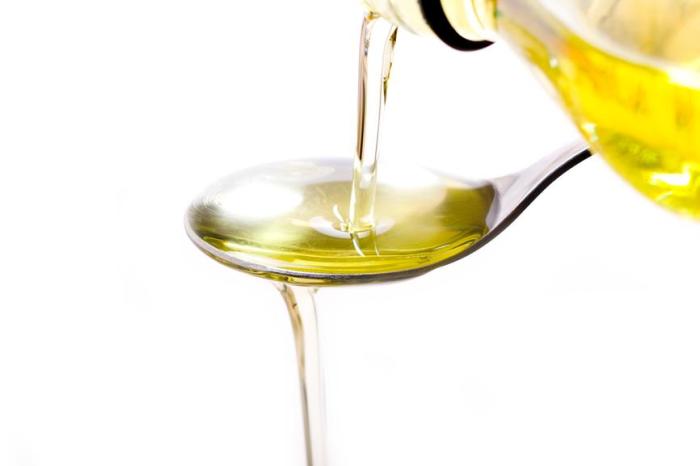
With long-term regular use, this product helps:
Get rid of excess weight. The fatty acids included in its composition act as weight loss activators and increase the effectiveness of the diet; Strengthen the heart and blood vessels. The elasticity of the walls of blood vessels increases, the amount of bad cholesterol decreases, blood pressure returns to normal and metabolism is activated; Normalize the functioning of the gastrointestinal tract
Consumption of flax oil prevents constipation (which is especially important in the postpartum period), improves the condition of hemorrhoids, has a beneficial effect on the liver, treats gastritis, and prevents the formation of stones in the bile ducts; Prevent the development of inflammatory processes, including fibrocystic mastopathy, gout, lupus; Improve skin condition; Normalize the activity of the nervous system; Prevent the development of malignant neoplasms.
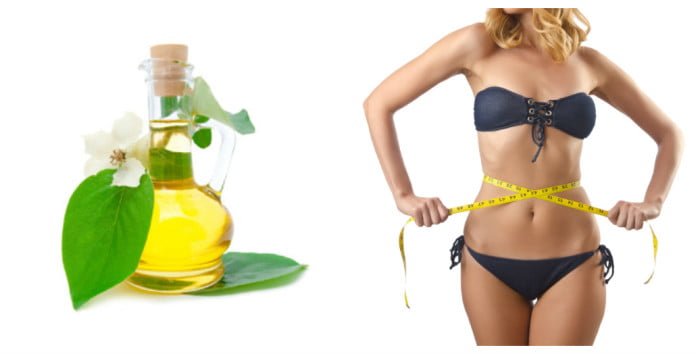
It is obvious that flaxseed oil can help a woman’s body recover quickly after childbirth and benefit the development of the child
Read about what foods help a nursing mother recover here. But you should also pay attention to the features of this product associated with the high content of plant estrogens.
Flaxseed porridge
Flax porridge is mainly made from oil cake - flax seeds, from which the oil has already been pressed (it differs from flour by being more coarsely ground). Therefore, it contains vitamins and microelements (they are present in the tissues of the seed), carbohydrates, fiber, but much less fatty acids and omega-3. Because of this, flaxseed porridge can and even should be consumed by pregnant and lactating women, it:
- increases tone;
- helps restore immunity after childbirth;
- improves the functioning of the gastrointestinal tract due to the large amount of fiber;
- improves the condition of the skin and cartilage tissue;
- improves overall well-being;
- helps normalize metabolism.
Porridge is mainly distinguished from flaxseed flour by its coarser grind.
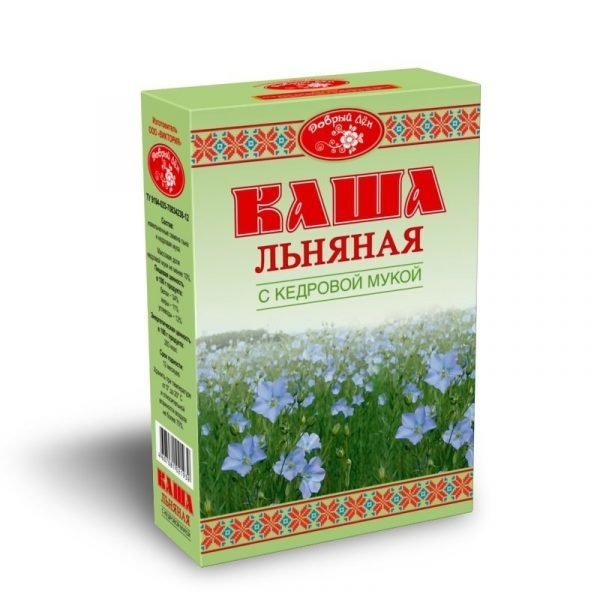
Flaxseed porridge is sold in grocery stores
Recipes that involve making porridge from whole seeds, as well as ground ones yourself, are also quite common. The fat content in it is also low, and there are many microelements. This porridge can be quite tasty, but requires preparation. Recipe:
- Leave flax seeds overnight in water at room temperature.
- Grind the swollen grains in a coffee grinder, blender or other similar method.
- Pour boiling water over the finished mixture.
- Next, cook the mixture over low heat for 4–5 minutes.
- Remove the porridge from the heat and let it brew for 10 minutes.
You can cook this porridge with milk, add honey, dried fruits, candied fruits to taste - it all depends on your preferences.
The simplest way (if you don't want to mess around):
- Pour half a glass of porridge (powder) into a plate.
- Pour boiling water over it.
- Cover with a lid or saucer and let steep for 15–20 minutes.
- You can also add syrups, honey, etc. for taste.
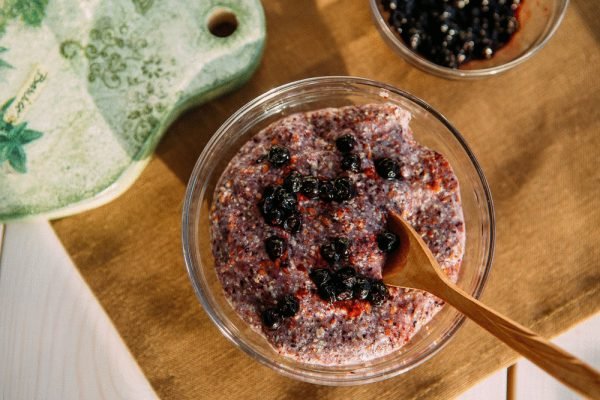
Various berries, dried fruits, and honey are added to flaxseed porridge.
This recipe uses freshly ground flax. Select proportions based on common sense and your own considerations.
- Soak raisins and prunes in water for 20–30 minutes.
- Then place in a blender along with the water in which the dried fruits were soaked and grind until smooth.
- Add bananas and chop again.
- Transfer the resulting puree to a plate, add freshly ground flax and mix thoroughly (preferably with a whisk).
Is it possible to eat or drink flax seeds while breastfeeding and in what form?
Doctors and lactation consultants do not have a consensus on the possibility of using flaxseeds for breastfeeding. Some believe that the harmful properties of the product are too great and such use is unsafe. The majority is inclined to think that the benefits significantly outweigh the harm, and side effects are quite rare, so the product can be eaten. It is better to consult with a specialist regarding the possibility of using flax in your case.
In the first month
It is recommended to introduce the product into the diet for the first time 3 months after birth, but it is also allowed when the baby is one month old. The child’s body will become strong enough to accept new products on the mother’s menu.
Doctor Komarovsky's opinion
Komarovsky speaks well of the benefits of flaxseed oil in the fight against constipation and helminths in children on breastfeeding. In addition, he talks about the benefits of flax for the prevention and control of rickets. Since flaxseeds have the same properties as oil, by analogy we can assume that they are no less useful for children during breastfeeding.
Oil
Flax seed oil is similar in composition to flax seeds. This is a concentrate of the useful substances of the product. Flaxseed oil is allowed for breastfeeding. It is much more effective than seeds in treating constipation. It is recommended to start using ½-¼ teaspoon per day. If there is no reaction, the dosage can be increased. The maximum dose is 2 tablespoons per day. Due to the unstable concentration of ligans in the oil, it is impossible to determine the exact dosage, and excessive use can lead to adverse reactions, so be sure to consult a doctor before taking it.
Read more in the article “Flaxseed oil for breastfeeding.”
Flaxseed flour
Flaxseed flour has recently been increasingly used in cooking. If you want to use it in baking, remember: flaxseed flour is used as an additive to wheat, oatmeal and other types of products. Its composition is too active for independent use, especially for nursing women.
You can buy it in a store or pharmacy, but the healthiest one is the one you prepare yourself. To do this, take flax seeds and mash them in a mortar. You can use a blender or coffee grinder, but the product reacts with the metal, which can give the flour a distinct flavor. It is best to use this flour immediately after production.
Flaxseed flour with kefir
Flaxseed flour is most often used by women for weight loss. A 3-week course to lose excess weight is recommended. It should be noted that for maximum effect you need to give up unhealthy foods, fried foods, flour products and drink a lot of clean water. The diet is based only on flour and kefir, so it is perfect for women who have gained extra pounds during pregnancy.
So, for 3 weeks you need to drink the following drink.
Compound:
- Flaxseed flour.
- Kefir.
Preparation:
Mix kefir with flour.
Proportions:
1 week - 1 teaspoon of flour per 100 ml of kefir.
Week 2 - 1 tablespoon of flour per 100 ml of kefir.
Week 3 - 3 tablespoons of flour per 200 ml of kefir.
Application: Drink the mixture cold in the morning on an empty stomach every day. You can't heat flax.
Urbech
It is recommended to use flaxseed urbech for breastfeeding from the age of 3 months. This product is rich in vitamins and minerals. If there is no allergy, it will help cope with many breastfeeding problems, including hypolactation. Flaxseed paste is believed to help increase the quantity and nutritional value of breast milk.
It is possible to prepare flax urbech at home yourself; read more about this in the article “How to prepare urbech from flax seeds at home?”
Decoction
It is recommended to drink a decoction of flax seeds for diseases of internal organs, especially the gastrointestinal tract. The second name of the drink is flaxseed jelly.
Compound:
- Flax seeds - 2 tsp.
- Boiling water - 1 glass.
Preparation:
- Pour boiling water over the seeds in a thermos.
- Let stand for 2 hours.
- Strain.
Application: Drink the liquid freshly prepared. Do not store the decoction for more than 2 days. During breastfeeding, it is forbidden to drink more than half a glass a day.
Porridge
Flaxseed porridge during breastfeeding is very beneficial for the body. Remember that multi-component dishes can be eaten by nursing women only after introducing the components separately into the diet.
For more information about the benefits of flax porridge for mothers and babies, read the article “Flax porridge during breastfeeding
You can prepare flaxseed porridge at home using the following recipes:
- Flax porridge with banana for nursing mothers.
- Flaxseed porridge with dates for breastfeeding mothers.
Flaxseed flour

Factory-produced flaxseed flour - crushed and well-dried flax seeds
Flaxseed flour comes in two types:
- Carefully ground and dried flax seeds, from which the oil has been previously pressed. This flour is a powder. Due to such processing, there are practically no fatty acids and mucus-forming substances left in it, but it is beneficial for the intestines due to its high fiber content. It can be heated and used when preparing baked goods and cutlets. Of all flax derivatives, flaxseed flour is the mildest way to strengthen the immune system and obtain nutrients. There are many recipes: it is added in small portions to kefir (a tablespoon per glass) and tea. Some brands of flour are prescribed to be used in cooking instead of wheat (but you need to carefully read the instructions on the package). For example, 1 tablespoon of flaxseed flour per 300–400 grams of minced meat will enrich the cutlets with additional nutrients. They even bake cookies from it, mixing it with regular flour.
- The second option for flaxseed flour is often made independently at home - it is ground or crushed flax seeds, the oil from which has not been pressed. Decoctions and infusions are prepared from it, but the issue of heat treatment still requires great care.
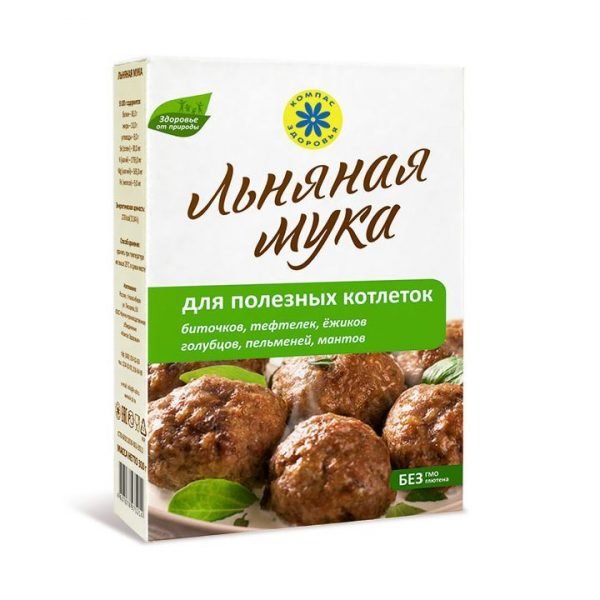
Some brands of flaxseed meal can also be added to everyday dishes.
Composition and properties of the product

The healing properties of the product are due to its unique composition - flax contains large quantities of essential fatty acids omega-3 and omega-6, vegetable protein, vitamins, and biologically active substances. Flax oil has a higher concentration of fatty acids compared to the seed, but is inferior to it in vitamin and mineral composition and fiber content. Experts classify flaxseed as a nutraceutical - natural energy substances that have a general strengthening and rejuvenating effect on the body. The product contains in significant quantities:
- easily digestible vegetable protein;
- fiber for quality digestion;
- B vitamins necessary to maintain the health of the nervous system and the beauty of the skin and hair;
- phytoestrogens, similar to female sex hormones;
- amino acids;
- valuable minerals (phosphorus, potassium, calcium, manganese, iron, selenium, zinc and others);
- lignins are phenols of plant origin that minimize the risk of breast cancer in women;
- fatty acids required for the full mental development of the child and maintaining the health of internal organs and systems, skin elasticity.
The calorie content of flax is quite high - about 550 kcal per 100 g in seeds, and 880 kcal per 100 ml in oil. This is due to the large proportion of vegetable fats in the product. In terms of the content of polyunsaturated fatty acids of the omega class, flax is superior even to fish oil.
Table: chemical composition and calorie content of flaxseed
| Nutrient | Quantity | % of the norm in 100 g* |
| Calorie content | 534 kcal | 31.7% |
| Squirrels | 18.29 g | 24.1% |
| Fats | 42.16 g | 70.3% |
| Carbohydrates | 28.88 g | 13.7% |
| Alimentary fiber | 27.3 g | 136.5% |
| Vitamins | ||
| Vitamin B1, thiamine | 1.644 mg | 109.6% |
| Vitamin B2, riboflavin | 0.161 mg | 8.9% |
| Vitamin B4, choline | 78.7 mg | 15.7% |
| Vitamin B5, pantothenic | 0.985 mg | 19.7% |
| Vitamin B6, pyridoxine | 0.473 mg | 23.7% |
| Vitamin B9, folates | 87 mcg | 21.8% |
| Vitamin E, alpha tocopherol, TE | 0.31 mg | 2.1% |
| Vitamin K, phylloquinone | 4.3 mcg | 3.6% |
| Vitamin RR, NE | 3.08 mg | 15.4% |
| Macronutrients | ||
| Potassium, K | 813 mg | 32.5% |
| Calcium, Ca | 255 mg | 25.5% |
| Magnesium, Mg | 392 mg | 98% |
| Phosphorus, Ph | 642 mg | 80.3% |
| Microelements | ||
| Iron, Fe | 5.73 mg | 31.8% |
| Manganese, Mn | 2.482 mg | 124.1% |
| Copper, Cu | 1220 mcg | 122% |
| Selenium, Se | 25.4 mcg | 46.2% |
| Zinc, Zn | 4.34 mg | 36.2% |
| Fatty acid | ||
| Omega-3 fatty acids | 22.813 g | 616.6% |
| Omega-6 fatty acids | 5.91 g | 100% |
| Monounsaturated fatty acids | 7.527 g | 40% |
| Polyunsaturated fatty acids | 28.73 g | 139.5 |
% of the norm in 100 g* - approximate figures for a middle-aged nursing mother
Photo gallery: flax seeds - use in cooking
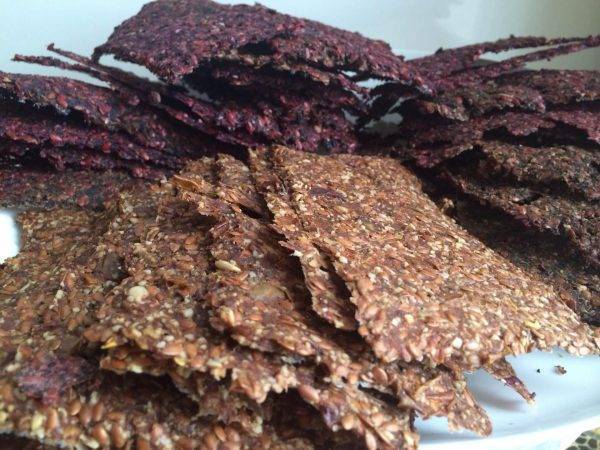
Kozinaki is prepared from flax seeds by filling them with concentrated sugar syrup.

You can add flax flour or whole seeds to baked goods.

Flax seeds can be combined with fermented milk drinks
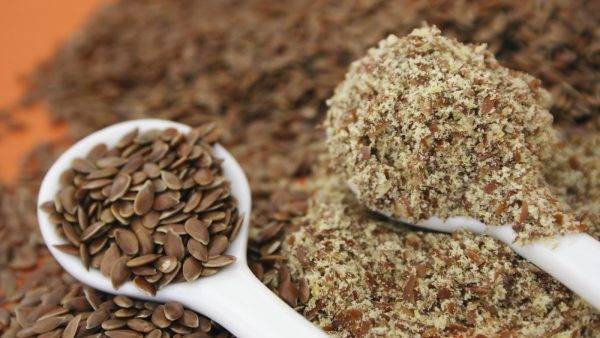
You can make flour from flax seeds yourself by grinding them in a coffee grinder or blender.
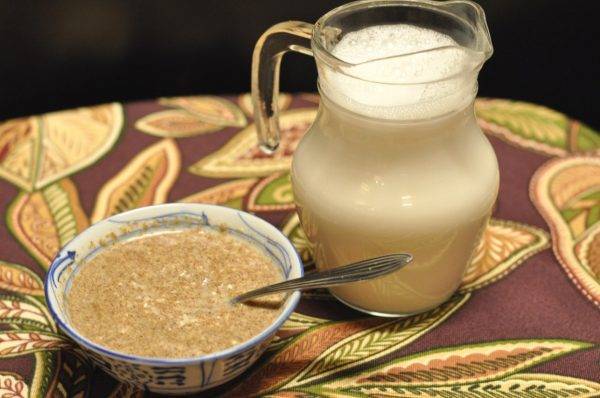
Porridge is cooked from flax seeds in milk
Flaxseed oil and HF: pros and cons
Polar opinions regarding the use of flaxseed oil after childbirth, during breastfeeding and during pregnancy forces us to study the product from all sides. Why are the judgments so opposite, what is the reason? Let's start with a composition that, in addition to a huge number of different useful elements, contains Omega 3 and 6 acids. For a woman who is breastfeeding and suffers from heart disease, flaxseed oil becomes useful.

When is flax oil useful?
Considering the multifaceted composition of flax oil, we can talk about its high healing properties. Among the positive properties of flax oil are the following:
- Reduce cholesterol levels with regular intake of oil.
- Positive effect on blood viscosity levels.
- Nutritionists recommend the product for use as a preventive measure. Flax oil prevents hypertension, has a beneficial effect on the functioning of a woman’s genitourinary system, improves the condition of the skin, and stabilizes kidney function.
- Can prevent heart attack and avoid atherosclerosis. Significantly reduces the risk of blood clots and stroke.
Taking the product during early pregnancy has a positive effect on the development of the fetal brain. Doctors advise using the oil for those who are having a difficult pregnancy and if there are concerns about the health of the baby.
The list of beneficial properties of the plant can be supplemented by its positive effect on the immune system and the functioning of the gastrointestinal tract. In addition, the oil perfectly regulates a woman’s hormonal levels after childbirth. Dr. Komarovsky maintains a positive opinion about the product, but always warns about proper dosage and consultation with specialists.
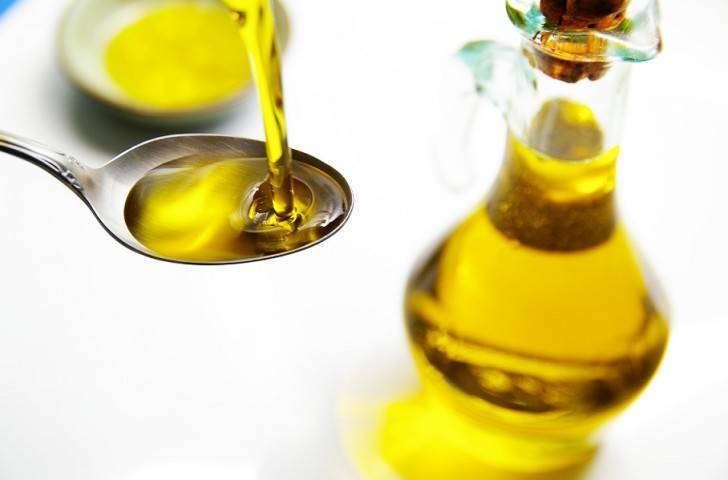
When should you not take flaxseed oil?
Opponents of the use of flaxseed oil note its negative impact on the fetus during gestation. Observations of pregnant mothers made it possible to establish some connection between its use and premature birth. There is no clear prohibition on taking the product during lactation, but doctors do not recommend consuming it in excessive quantities. The baby’s body may react poorly to the oil’s substances and respond with serious intestinal upset.
Flax oil can increase postpartum bleeding in the mother. You should absolutely avoid the product if you have had a caesarean section. Oil should not be used if you have diseases of the liver, gastrointestinal tract, or thyroid gland. The ban also applies to the following ailments:
- endometritis and uterine fibroids;
- erosions in the intestines;
- problems with the bile ducts;
- high blood pressure.
How to use the oil?
- Use a tablespoon of oil inside twice a day.
- The product is effective against stretch marks. If you lubricate annoying strips with it, it will soften the skin and improve cell regeneration. By adding a few drops of oil to your moisturizer, you will enhance its healing effect.
- The product works well for the beauty of the breasts, restores their elasticity, and reduces the risk of mastitis.
- During lactation, oil should be lubricated on injured nipples to speed up healing.
Everything new is well forgotten old. A decoction of flax seeds has traditionally been used during breastfeeding. Today, young mothers often seek advice from doctors about using the seeds of this plant to increase milk supply. What do experts think about this?
Flaxseed oil and HF: pros and cons
Polar opinions regarding the use of flaxseed oil after childbirth, during breastfeeding and during pregnancy forces us to study the product from all sides. Why are the judgments so opposite, what is the reason? Let's start with a composition that, in addition to a huge number of different useful elements, contains Omega 3 and 6 acids. For a woman who is breastfeeding and suffers from heart disease, flaxseed oil becomes useful.
Considering the multifaceted composition of flax oil, we can talk about its high healing properties. Among the positive properties of flax oil are the following:
- Reduce cholesterol levels with regular intake of oil.
- Positive effect on blood viscosity levels.
- Nutritionists recommend the product for use as a preventive measure. Flax oil prevents hypertension, has a beneficial effect on the functioning of a woman’s genitourinary system, improves the condition of the skin, and stabilizes kidney function.
- Can prevent heart attack and avoid atherosclerosis. Significantly reduces the risk of blood clots and stroke.
The list of beneficial properties of the plant can be supplemented by its positive effect on the immune system and the functioning of the gastrointestinal tract. In addition, the oil perfectly regulates a woman’s hormonal levels after childbirth. Dr. Komarovsky maintains a positive opinion about the product, but always warns about proper dosage and consultation with specialists.
Opponents of the use of flaxseed oil note its negative impact on the fetus during gestation. Observations of pregnant mothers made it possible to establish some connection between its use and premature birth. There is no clear prohibition on taking the product during lactation, but doctors do not recommend consuming it in excessive quantities. The baby’s body may react poorly to the oil’s substances and respond with serious intestinal upset.
Flax oil can increase postpartum bleeding in the mother. You should absolutely avoid the product if you have had a caesarean section. Oil should not be used if you have diseases of the liver, gastrointestinal tract, or thyroid gland. The ban also applies to the following ailments:
- endometritis and uterine fibroids;
- erosions in the intestines;
- problems with the bile ducts;
- high blood pressure.
- Use a tablespoon of oil inside twice a day.
- The product is effective against stretch marks. If you lubricate annoying strips with it, it will soften the skin and improve cell regeneration. By adding a few drops of oil to your moisturizer, you will enhance its healing effect.
- The product works well for the beauty of the breasts, restores their elasticity, and reduces the risk of mastitis.
- During lactation, oil should be lubricated on injured nipples to speed up healing.
https://youtube.com/watch?v=ZFHHmf6egvk
https://youtube.com/watch?v=ZFHHmf6egvk
Oil
The medicinal plant is introduced into the diet during lactation in the form of oil. It is added to ready-made dishes and is not used for frying, since heat treatment removes most of the beneficial substances. The oil relaxes the muscles of the internal organs. Acts as an expectorant. Once in the stomach, it envelops it and treats inflammation, enriching the body with valuable omega-3 and omega-6 acids. Do not take oil if you have gallstones, acute pancreatitis, or hepatitis.

Flaxseed oil during breastfeeding
The benefits of flaxseed oil have been known for a long time; it is a source of Omega-3 acid and polyunsaturated lipids, which are important for the body. Flaxseed oil during breastfeeding has a beneficial effect on mother and baby, nourishing the body with elements that promote proper development and growth
Flaxseed oil during breastfeeding has a beneficial effect on mother and baby, nourishing the body with elements that promote proper development and growth.
It is important to remember that everything that the mother ate gets into the baby through breast milk during the day; she is the primary source of vitamins for the baby
The benefits of flaxseed oil for mothers during lactation
This natural component helps a young mother restore her body during the postpartum period.
Flax seeds have the following advantages:
serve as an excellent way to boost immunity, especially everything related to respiratory diseases; stabilize hormonal levels and have a beneficial effect on the thyroid gland
Which is very important for a woman, since very often an imbalance in the thyroid gland appears precisely after childbirth, justifying this as a hormonal imbalance. In endocrinology, this is given a special place and a number of preventive measures are carried out during pregnancy; stabilizes the functioning of the gastrointestinal tract
It helps very well with constipation, which often accompanies a woman after childbirth for several months; has a rejuvenating effect. Thanks to the vegetable fats contained in flax - Omega-3, fiber and lagnan - it nourishes the woman’s body, giving a fresh glow to the hair and skin.
How to take flax seeds? And who should refrain from using it?
Despite the presence of a lot of useful substances in this natural component, young mothers during breastfeeding should consult a doctor about the possibility of taking it orally. That's because medicine has not yet come to a consensus on the positive effects on the body of an expectant and young mother.
Thus, Canadian scientists claim that flax seed should not be consumed during the second and third trimester of pregnancy, as well as during lactation. And on the contrary, other colleagues never cease to prove the positive effect of flax elements on the formation of the baby’s brain activity, which he receives through breast milk.
Russian medicine allows you to take flax as vegetable oil in cold appetizers and salads. However, it is not recommended to use it on an empty stomach. The main recommendation that exists when consuming flaxseed oil is its natural origin and naturalness.
Contraindications to taking flax seed
- if a woman has diseases such as pancreatitis, inflammation of the biliary tract, polycystic disease, endometritis, as well as a tendency to increase blood pressure;
- the presence of inflammatory processes in the intestinal tract.
How to take flax oil?
For an ordinary person, the standard portion per day is 2 tablespoons. But for nursing mothers, it is recommended to reduce the dose level to 1 tablespoon.
- start taking one teaspoon, gradually increasing the dose to one tablespoon;
- flax oil should be added to salads and cold appetizers;
- for greater effectiveness, it should be consumed with foods that contain vitamins E and B6;
- Under no circumstances should you fry with flaxseed oil or add it to hot soups. At high temperatures, it can release toxic elements and, as a result, lose its beneficial properties;
Prohibited! Take the oil orally in the morning on an empty stomach.
How does flax oil affect a baby?
- stimulates the gastrointestinal tract and eliminates constipation;
- strengthens the immune system and serves as a prevention of respiratory diseases;
- increases appetite with low acidity of gastric juice.
Allergic reactions when taking flaxseed oil.
Flax oil is not as common an allergen as peanut butter or protein. But, nevertheless, each organism is individual and has its own characteristics. Therefore, for some it can be especially dangerous.
Signs of an allergy to flaxseed oil:
- dizziness;
- swelling of the face, possibly neck and throat;
- the occurrence of difficulty breathing and rapid heartbeat.
Worth remembering! That flaxseed oil has a lot of its advantages and positive effects on the body, as well as negative consequences. Therefore, you should consult a doctor before use.
How to select and store
The product is sold whole or crushed. Each packaging form has its own pros and cons. Flax seeds for a nursing mother are preferable in powder form - this makes them easier to chew. It is not easy to process raw materials yourself, so it is more convenient to purchase a ground product.
The whole seed is stored throughout the year in a dark, cool, dry place. Crushed ones have a shorter shelf life. The product can be stored in vacuum packaging for 6-16 weeks.
When choosing flax seeds during lactation, look at the expiration date. It is recommended to pay attention to freshness. There should be no traces of moisture on the packaging; it is preferable that it be vacuum sealed. After purchase, the seeds are placed in an airtight container and placed on the refrigerator shelf, where they can be stored for up to two years.
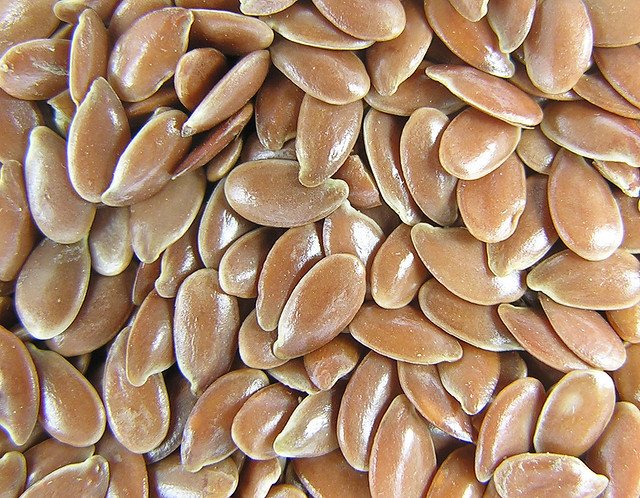
Why it's useful
Flax seed oil has a multicomponent composition, which is represented by organic acids, amino acids, Omega-3, B vitamins, as well as A, E, K, iron, magnesium, phosphorus, manganese, and phytoestrogens.
Omega-3s are vital for the proper functioning of the body. Like a filter, they protect cell membranes from the penetration of harmful substances. Many medical studies confirm that fatty acid significantly reduces the risk of developing cardiovascular pathologies
As evidence, it is worth paying attention to the inhabitants of Japan and the Mediterranean. Their diet includes fish (also a source of Omega-3) almost every day and rates of heart disease in these countries are lower
Fatty acids are not synthesized by the body independently and come only from food: seeds, seafood, fish, avocados, vegetable oils. Most people do not consume enough of these foods, so flax seed oil can help fill Omega-3 deficiency.
As a dietary supplement, the product is beneficial for all genders, but is especially important for women's health. Here are just some arguments regarding the benefits of flaxseed oil for women:
- It has a normalizing effect on prostegerone levels, helps normalize the menstrual cycle, reduces the unpleasant symptoms of PMS, and improves the condition during menopause. Due to the content of healthy fats, it inhibits the synthesis of prostaglandins, which provoke heavy discharge during menstruation.
- Promotes better absorption of calcium and thereby helps avoid osteoporosis.
- The rich composition of the healing product preserves the elasticity of blood vessels, prevents the formation of blood clots and, in combination with drug therapy, is a good assistant in the fight against varicose veins.
- Used to restore functions of the reproductive system. In alternative medicine it is used to treat infertility. Helps normalize hormonal levels and ovulation.
- Normalizes the level of bad cholesterol, clears blood vessels of plaque and minimizes the risk of heart attacks.
- Increases the body's protective functions and prevents inflammatory processes.
- Thanks to the content of antioxidants and vitamin E, it resists cell aging, accelerates their regeneration, thereby helping to maintain youth. Flaxseed oil is useful not only when consumed internally, but also as part of face masks. Procedures using it smooth out wrinkles, saturate the dermis with moisture, vitamins, minerals, and give the skin elasticity.
- Improves the condition of the skin, strengthens hair and nails. Flax oil has proven itself well as a remedy against acne, dermatitis, and eczema.
- Relieves asthmatic conditions.
- Eliminates such a delicate problem as constipation and normalizes intestinal function.
Flaxseed oil and HF: pros and cons
Polar opinions regarding the use of flaxseed oil after childbirth, during breastfeeding and during pregnancy forces us to study the product from all sides. Why are the judgments so opposite, what is the reason? Let's start with a composition that, in addition to a huge number of different useful elements, contains Omega 3 and 6 acids. For a woman who is breastfeeding and suffers from heart disease, flaxseed oil becomes useful.
Flax seeds can be added to various dishes, however, it is important not to overdo it with the use of a healthy product
When is flax oil useful?
Considering the multifaceted composition of flax oil, we can talk about its high healing properties. Among the positive properties of flax oil are the following:
- Reduce cholesterol levels with regular intake of oil.
- Positive effect on blood viscosity levels.
- Nutritionists recommend the product for use as a preventive measure. Flax oil prevents hypertension, has a beneficial effect on the functioning of a woman’s genitourinary system, improves the condition of the skin, and stabilizes kidney function.
- Can prevent heart attack and avoid atherosclerosis. Significantly reduces the risk of blood clots and stroke.
The list of beneficial properties of the plant can be supplemented by its positive effect on the immune system and the functioning of the gastrointestinal tract. In addition, the oil perfectly regulates a woman’s hormonal levels after childbirth. Dr. Komarovsky maintains a positive opinion about the product, but always warns about proper dosage and consultation with specialists.
When should you not take flaxseed oil?
Opponents of the use of flaxseed oil note its negative impact on the fetus during gestation. Observations of pregnant mothers made it possible to establish some connection between its use and premature birth. There is no clear prohibition on taking the product during lactation, but doctors do not recommend consuming it in excessive quantities. The baby’s body may react poorly to the oil’s substances and respond with serious intestinal upset.
Flax oil can increase postpartum bleeding in the mother. You should absolutely avoid the product if you have had a caesarean section. Oil should not be used if you have diseases of the liver, gastrointestinal tract, or thyroid gland. The ban also applies to the following ailments:
- endometritis and uterine fibroids;
- erosions in the intestines;
- problems with the bile ducts;
- high blood pressure.
How to use the oil?
- Use a tablespoon of oil inside twice a day.
- The product is effective against stretch marks. If you lubricate annoying strips with it, it will soften the skin and improve cell regeneration. By adding a few drops of oil to your moisturizer, you will enhance its healing effect.
- The product works well for the beauty of the breasts, restores their elasticity, and reduces the risk of mastitis.
- During lactation, oil should be lubricated on injured nipples to speed up healing.
Decoction
The healing product contains vitamins A, B, C, D, E, K, PP, omega-3 and omega-6 acids. When breastfeeding, flax seeds are brewed and taken as a prophylactic for stomach diseases, for the treatment of pancreatitis, and for constipation. Do not drink it if you have serious pathologies of the liver, kidneys, or female reproductive system.
To prepare a product from whole seeds, pour a glass of raw material into a container, fill it with three liters of water and heat it in a water bath for several hours. The finished product is cooled and filtered. Drink three times a day 30 minutes before meals.
To make a decoction of ground flax, boil a couple of glasses of water. Put 2 tbsp. l. seeds and cook for 30 minutes. Take on an empty stomach 4 times a day. The introduction of the decoction during lactation begins with one teaspoon. If there is no negative reaction in the child, the volume is adjusted to half a glass.
